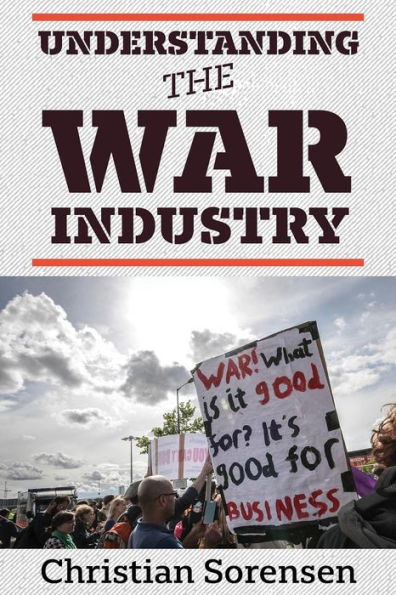

Paperback
-
PICK UP IN STORECheck Availability at Nearby Stores
Available within 2 business hours
Related collections and offers
Overview

Product Details
| ISBN-13: | 9781949762228 |
|---|---|
| Publisher: | Clarity Press, Incorporated |
| Publication date: | 08/01/2020 |
| Pages: | 444 |
| Product dimensions: | 5.90(w) x 9.00(h) x 1.20(d) |
About the Author
Read an Excerpt
This book proceeds on the basis of a few foundational facts: (1) The United States of America is no longer a republic, but an oligarchy.2 (2) Capital is concentrated in very few hands.3 (3) The Department of War is not the predominant decision-maker on matters of war and peace. The boardrooms of U.S. corporations are. This unelected bureaucracy has attained war-making authority without democratic debate, let alone democratic support. The information provided here regarding corporations comes from the Pentagon's daily contract announcements,4 unless otherwise cited. Individually, these daily announcements seem of little import. But years of cataloguing and arranging the contracts have yielded significant details, patterns, and themes, documented here. As a hero of mine once said, “A lot of tape and a little patience make all the difference.” The reporting of journalists, brochures and press releases issued by corporations, interviews, and my own independent experiences supplement my research. As this book confirms, the wars the U.S. government wages do not cater to the needs of the U.S. citizenry. Today's wars are propelled by the need of corporate behemoths to accrue ever greater profits. U.S. public opinion has no effect on decisions of war and peace. The public may feel free to comment, but the path had already been chosen. This book is neither an official account nor a specialist military history. Many battles, events, and turning points are omitted. Units of the U.S. Armed Forces are only mentioned when it is illustrative of the goods and services sold by corporations or of a significant pattern of behavior within the war industry as a whole. This book gives the industry point of view. It does not intend to imply that industry is omnipotent or that the Pentagon doesn't eagerly gobble up goods and services for its own narrow purposes. But, despite the extent of documentation provided here, this is not a comprehensive review. The U.S. war industry is far too massive to thoroughly capture or map within a single volume. The focus instead is on the ways the industry operates, on its overall structure and patterns. This book is intended as a thorough introduction to the issue. In a nutshell, it lays out how the U.S. war industry operates.
Table of Contents
Preface ix
Chapter 1 The Big Picture 1
Trillions 1
Carnage 1
Pollution 3
Occupying Afghanistan, Destroying Iraq 8
Boss 13
Bombing 18
Industry Locations 20
Justifications 24
Futures Command 27
Endnotes 30
Chapter 2 Magnifying Influence 46
Pulling In Military Retirees 47
Stacking the Pentagon Deck 50
Shattering the Glass Ceiling 52
Campaign Finance 54
Lobbying 61
Pressure Groups 66
Banking and Investment Firm Stakeholders 68
Corporate Media & Think Tanks 70
Endnotes 76
Chapter 3 Financials and Legalese 92
Contract Types 92
Multifarious Funding/Incessant Purchasing 93
Weaseling the Contracts 97
Inculpating Small Business 99
Seducing Native Americans 101
The (Failed) Audit 103
Offices & Administration 106
Ensuring Legal Impunity 107
Propagandizing Recruitment 113
Endnotes 117
Chapter 4 The Tricks of the Trade 133
Cooperation 133
Memes 134
Threat Fabrication 138
Ruses 143
Built-in Obsolescence 146
Euphemisms 148
Endnotes 153
Chapter 5 Foreign Military Sales 164
Rationalizations 164
The MQ-4C Triton 165
A Single Month's Sales 166
Zionism, an Industry Perspective 168
A Tale of Two Regimes: D.C. and the House of Saud 173
Selling to Countries Within Central Command 176
Selling to the U.S. for Operations Within Central Command 177
Outposts, Death, and Airwars 181
Gotta Get That Cash 186
The Key to Military Policy 187
Endnotes 190
Chapter 6 The Academy 207
Beantown & Beyond 207
Stanford University 212
Computing, Colonization, and Language Capacity 214
Johns Hopkins, the Star 218
Higher Education 221
Labs & Centers 223
Militarizing Education 224
Brain Drain 228
Endnotes 230
Chapter 7 Information Technology 241
Information Takeover 241
Intel 244
Managing Data Overload 248
Cloudy with a Chance of Fleecing 249
Amazon 250
Microsoft 252
Google 253
A Taste of C4ISR & CACI 255
Cyber 259
DMT and Special Relationships 261
Endnotes 265
Chapter 8 "Our" Hemisphere 277
SOUTHCOM 277
Brazil 281
Honduras 282
Colombia 283
Mexico 286
Special Marketing Ops 287
The Puerto Rican Colony 289
Guantánamo: Occupied Territory 295
Endemic Tunnel Vision 296
Endnotes 299
Chapter 9 The Nuclear Arsenal 313
Ogden 313
Beyond Reckless 314
MDA 316
The Modernization Scam 321
Endnotes 326
Chapter 10 Remotely Piloted Vehicles and Space Assets 336
Unmanned Aerial Vehicles 336
In Your FACE (Fairs, Air Shows. Conferences, Exhibits) 338
Variations on a Theme 340
Death Toll 342
One Season 343
Space: The Final Profiteer 345
Space Force 351
Endnotes 353
Chapter 11 Two, Three, Many Special Operations 366
The Status Quo 366
Superheroes or Super Profit? 368
Provisioning Hyper-Enabled Operators 372
SOFIC 2019 and MARS OF 2030 375
SOF Construction for Nonstop War 378
Seeking New Enemies 379
Endnotes 380
Chapter 12 Transitioning 389
Education and Organizing 389
Elections and Legislation 390
Demobilization 391
Disobedience 391
The Draft 392
Demilitarizing Industry 392
International Solidarity 395
Prosecutions 396
Redirecting Funding 397
Endnotes 398
Acronyms & Initialisms 402
Index 404
